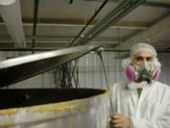FLAVORINGS-RELATED LUNG DISEASE

Current NIOSH Activities and Research
NIOSH is pursuing a range of research activities in the area of flavoring-related lung disease:
- Exploring several areas to expand and improve exposure assessment of flavoring compounds. With recent toxicological evidence suggesting the importance of diacetyl and other alpha dicarbonyl compounds, NIOSH is developing a sampling and analytical method for vapors of these compounds based on derivatization with the reagent 1,2-phenylenediamine. The derivatization provides very low detection limits in the analysis. Because the derivatization occurs during sampling, it is expected to increase the maximum volume of air that can be sampled, which would enable full shift sampling without change-out of the samplers. There is also concern about exposure to airborne dusts containing diacetyl and other flavoring compounds. A method is being developed involving filter sampling of airborne dusts, followed by head-space solid-phase microextraction (HS-SPME) of water extracts and analysis by gas chromatography-mass spectrometry (GC-MS). Finally, because flavoring environments are frequently complex, containing a wide variety of volatile organic compounds (VOCs), NIOSH is interested in methods that can measure a broad range of VOCs in a single sample. In pursuit of this goal, NIOSH is investigating evacuated canister and helium diffusion sampling (HDS) followed by GC-MS analysis. Both techniques collect whole air samples in which the components remain in the vapor phase until analysis. Both techniques have the advantages of pump-free sampling; no adsorption/desorption of analytes to/from sampling media; and it provides excellent sensitivity because, unlike methods requiring solvent extraction of sorbents, a large portion of the collected sample can be used for analysis.
- Conducting an industrywide exposure assessment study to characterize exposure to flavoring compounds, including diacetyl, in the food production industry. The study has focused on dairy, snack foods, confections and baked goods. Exposure assessment surveys were carried out at 10 facilities in 2009 and 2010. Data analysis is on-going. This study will provide important information on workplace exposures and guidance on work practices in food production to reduce occupational exposures to diacetyl and food flavorings.
- Assessing engineering controls in parallel with the industrywide exposure assessment study to evaluate potential reduction and control of exposure to flavoring compounds in the food production industry. This second phase of the study was focused on the “down-stream users” of food flavorings (dairy, snack foods, confections, and baked goods). Reports are being drafted to disseminate findings on these investigations, and recommendations will be provided to those facilities with potential exposure control issues.
- Developing guidance for respirators. Respirators also have an important role in worker protection. NIOSH respirator researchers are studying the effectiveness with which respirators are able to filter out diacetyl and other potentially harmful flavoring chemicals.
- Learning more about the health effects of flavoring exposures. Laboratory researchers are studying the acute inhalation toxicity of flavoring agents, identifying why flavorings are toxic in airways, and developing methods for more rapid screening of flavoring agents to assess whether they have potential for airways toxicity. For example, in 2010, NIOSH laboratory researchers reported that inhaled 2,3-pentanedione, sometimes used as a diacetyl substitute, injures airway epithelium in rats in a fashion resembling diacetyl [ Hubbs et al, 2010 [PDF - 49 KB] ]. Risk assessors are working with available epidemiological and toxicological data to determine how much exposure is needed to cause lung disease. There is ongoing interest in restrictive spirometry excesses being found in flavoring-exposed workers, with on-going analyses of health hazard evaluation data to assess the extent to which excesses of restrictive spirometric abnormalities exist and plans to obtain and analyze lung volume, diffusing capacity, and radiologic tests to examine whether these abnormalities reflect a spectrum of lung disease apart from clinical obliterative bronchiolitis.
- Page last reviewed: August 11, 2011
- Page last updated: February 23, 2017
- Content source:
- National Institute for Occupational Safety and Health Respiratory Health Division


 ShareCompartir
ShareCompartir